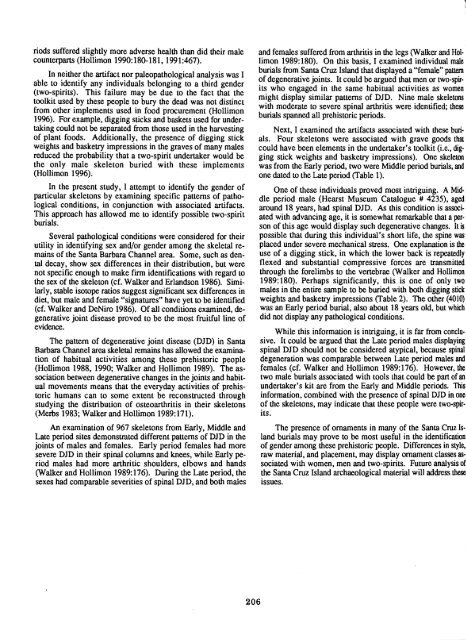SEX, GENDER AND HEALTH AMONG THE CHUMASH - Society for ...
SEX, GENDER AND HEALTH AMONG THE CHUMASH - Society for ...
SEX, GENDER AND HEALTH AMONG THE CHUMASH - Society for ...
Create successful ePaper yourself
Turn your PDF publications into a flip-book with our unique Google optimized e-Paper software.
iods suffered slightly more adverse health than did their male<br />
counterparts (Hollimon 1990: 180-181, 1991:467).<br />
In neither the artifact nor paleopathological analysis was I<br />
able to identify any individuals belonging to a third gender<br />
(two-spirits). This failure may be due to the fact that the<br />
toolkit used by these people to bury the dead was not distinct<br />
from other implements used in food procurement (Hollimon<br />
1996). For example, digging sticks and baskets used <strong>for</strong> undertaking<br />
could not be separated from those used in the harvesting<br />
of plant foods. Additionally, the presence of digging stick<br />
weights and basketry impressions in the graves of many males<br />
reduced the probability that a two-spirit undertaker would be<br />
the only male skeleton buried with these implements<br />
(Hollimon 1996).<br />
In the present study, I attempt to identify the gender of<br />
particular skeletons by examining specific patterns of pathological<br />
conditions, in conjunction with associated artifacts.<br />
This approach has allowed me to identify possible two-spirit<br />
burials.<br />
Several pathological conditions were considered <strong>for</strong> their<br />
utility in identifying sex and/or gender among the skeletal remains<br />
of the Santa Barbara Channel area. Some, such as dental<br />
decay, show sex differences in their distribution, but were<br />
not specific enough to make firm identifications with regard to<br />
the sex of the skeleton (cf. Walker and Erlandson 1986). Similarly,<br />
stable isotope ratios suggest significant sex differences in<br />
diet, but male and female "signatures" have yet to be identified<br />
(cf. Walker and DeNiro 1986). Of all conditions examined, degenerative<br />
joint disease proved to be the most fruitful line of<br />
evidence.<br />
The pattern of degenerative joint disease (DJD) in Santa<br />
Barbara Channel area skeletal remains has allowed the examination<br />
of habitual activities among these prehistoric people<br />
(Hollimon 1988. 1990; Walker and Hollimon 1989). The association<br />
between degenerative changes in the joints and habitual<br />
movements means that the everyday activities of prehistoric<br />
humans can to some extent be reconstructed through<br />
studying the distribution of osteoarthritis in their skeletons<br />
(Merbs 1983; Walker and Hollimon 1989:171).<br />
An examination of 967 skeletons from Early, Middle and<br />
Late period sites demonstrated different patterns of DJD in the<br />
joints of males and females. Early period females had more<br />
severe DJD in their spinal columns and knees, while Early period<br />
males had more arthritic shoulders, elbows and hands<br />
(Walker and Hollimon 1989:176). During the Late period, the<br />
sexes had comparable severities of spinal DJD, and both males<br />
and females suffered from arthritis in the legs (Walker and HoI·<br />
limon 1989:180). On this basis, I examined individual male<br />
burials from Santa Cruz Island that displayed a "female" pattern<br />
of degenerative joints. It could be argued that men or two·spir.<br />
its who engaged in the same habitual activities as women<br />
might display similar patterns of DJD. Nine male skeletons<br />
with moderate to severe spinal arthritis were identified; these<br />
burials spanned all prehistoric periods.<br />
Next, I examined the artifacts associated with these buri·<br />
als. Four skeletons were associated with grave goods that<br />
could have been elements in the undertaker's toolkit (Le., dig·<br />
ging stick weights and basketry impressions). One skeleton·<br />
was from the Early period, two were Middle period burials, and<br />
one dated to the Late period (Table 1).<br />
One of these individuals proved most intriguing. A Mid·<br />
dIe period male (Hearst Museum Catalogue # 4235), aged<br />
around 18 years, had spinal DJD. As this condition is associ·<br />
ated with advancing age, it is somewhat remarkable that a per·<br />
son of this age would display such degenerative changes. It is<br />
possible that during this individual's short life, the spine was<br />
placed under severe mechanical stress. One explanation is the<br />
use of a digging stick, in which the lower back is repeatedly<br />
flexed and substantial compressive <strong>for</strong>ces are transmitted<br />
through the <strong>for</strong>elimbs to the vertebrae (Walker and Hollimon<br />
1989:180). Perhaps significantly, this is one of only two<br />
males in the entire sample to be buried with both digging stick<br />
weights and basketry impressions (Table 2). The other (4010)<br />
was an Early period burial, also about 18 years old, but which<br />
did not display any pathological conditions.<br />
While this in<strong>for</strong>mation is intriguing, it is far from conclu·<br />
sive. It could be argued that the Late period males displaying<br />
spinal DJD should not be considered atypical, because spinal<br />
degeneration was comparable between Late period males and<br />
females (cf. Walker and Hollimon 1989:176). However, the<br />
two male burials associated with tools that could be part of an<br />
undertaker's kit are from the Early and Middle periods. This<br />
in<strong>for</strong>mation, combined with the presence of spinal DJD in one<br />
of the skeletons, may indicate that these people were two·spir·<br />
its.<br />
The presence of ornaments in many of the Santa Cruz Is·<br />
land burials may prove to be most useful in the identification<br />
of gender among these prehistoric people. Differences in style,<br />
raw material, and placement, may display ornament classes associated<br />
with women, men and two-spirits. Future analysis of<br />
the Santa Cruz Island archaeological material will address these<br />
issues.<br />
206
















